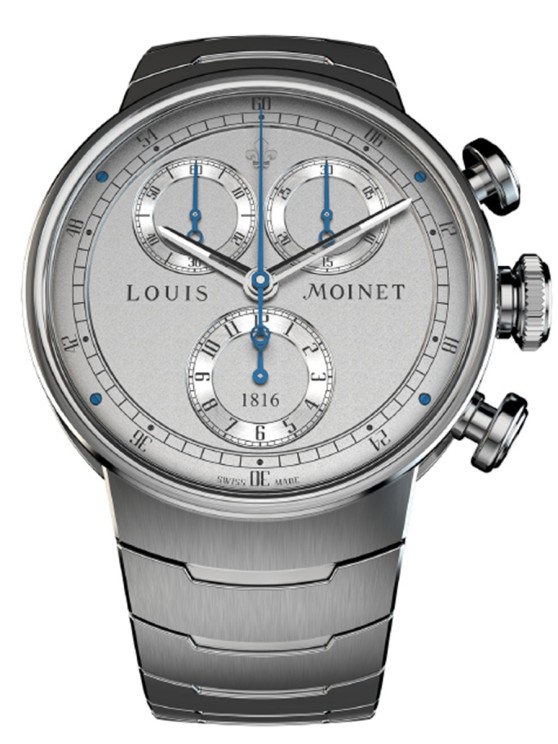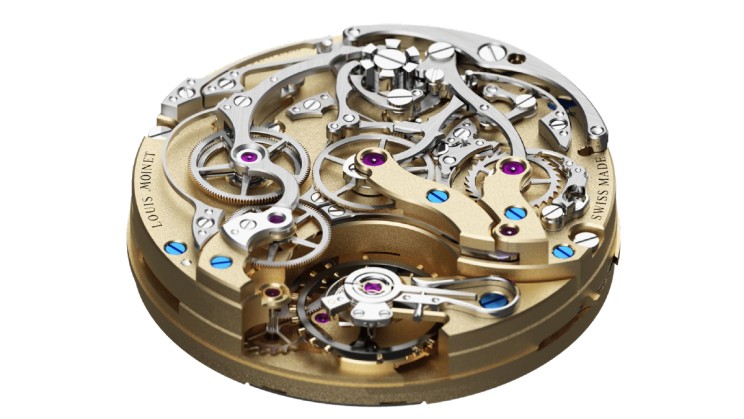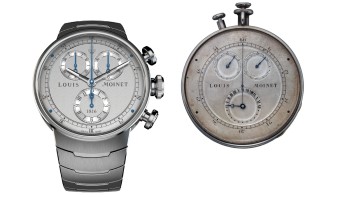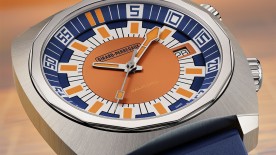Jean-Marie Schaller, founder and creative director of Ateliers Louis Moinet, is never short of ideas to celebrate the memory of “Louis,” as he likes to refer to him by his first name. The connection across the centuries is tangible between the two men. In his office in Saint-Blaise, Jean-Marie Schaller works continuously under the gaze of the esteemed watchmaker, whose portrait adorns the walls. Thus, with the weight and responsibility of history, the Ateliers that now bear his name unveil a piece closely linked to the first chronograph in history: the Compteur de Tierces created by Louis Moinet in 1816.
The creation was revealed during Watches and Wonders in Geneva. Its significance is such that the Ateliers have made it the only true novelty of the entire year 2025. Focus is therefore maximized on this unprecedented chronograph, which pays a strong tribute to its ancestor.
A Clear Family Resemblance
On the dial side, the aesthetic lineage is evident. The tri-compax appearance of the original piece is preserved. The arrangement of the counters is unique: the seconds and minutes (with an instantaneous counter) are shifted upwards on the dial; the 12-hour counter, slightly oversized, is positioned at 6 o'clock. This is a faithful transcription of the 1816 Compteur de Tierces. However, as we will see later, this layout did have an impact on the movement.
The central hand, initially dedicated to the thirds, is replaced by the conventional trio of hour, minute, and second hands. However, the Ateliers preserved the scale for measuring the sixtieth of a second, with graduations every 6 ticks.
Another adaptation to modernity: the pushers for starting, stopping, and resetting are moved to the right side of the case for practicality—and for a good reason, as the Compteur de Tierces was a pocket watch, while the 1816 is a wristwatch. Nevertheless, the geometry of the chronograph's pushers stays true to the design found over two centuries ago on Louis Moinet’s invention.
The First Metal Bracelet from Ateliers Louis Moinet
The other major novelty is its titanium bracelet. This is the first one created by Ateliers Louis Moinet. It is part of the current trend celebrating the return of metal bracelets, as seen in many independent watch brands. It features only a single satin-finished central link, with discreet mirror-polished inserts to ensure smooth articulation. The geometry is elegant and atypical, allowing the 1816 to display a boldly claimed modernity.

In-House and Custom Movement
On the movement side, the arrangement of the chronograph's counters required the development of a bespoke caliber. It contains 330 components. It is designed by Concepto (La Chaux-de-Fonds) and assembled in the Breuleux workshop of the Mercier family, with whom Jean-Marie Schaller has been working for 15 years. This movement is exclusive to the 1816. It reflects the typical spirit of the early 19th century, close to the constructions of the Vallée de Joux.

It features large bridges, constructed in height, providing a beautiful depth to the escapement. For the first time at Louis Moinet, the escapement is equipped with a swan-neck regulator. The movement, with its exemplary finish, is housed in a 40.6 mm titanium case with a height of 14 mm, a size favored by collectors. The bracelet is also made of titanium.
First Non-Limited Louis Moinet
Finally, it is worth noting that, for the first time since their inception, Ateliers Louis Moinet will not limit the 1816. Jean-Marie Schaller has ordered the first 500 movements. The piece will be priced at around 28,000 CHF including taxes, an exceptionally low price for this level of excellence, originality, and microblasted 3N finish, with a significant historical charge: the first chronograph in history.






